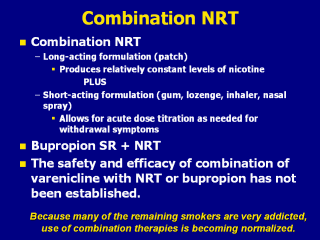| front |1 |2 |3 |4 |5 |6 |7 |8 |9 |10 |11 |12 |13 |14 |15 |16 |17 |18 |19 |20 |21 |22 |23 |24 |25 |26 |27 |28 |29 |30 |31 |32 |33 |34 |35 |36 |37 |38 |39 |40 |41 |review |
 |
Combination NRT Combination NRT involves the use of a long-acting formulation (patch) in combination with a short-acting formulation (gum, lozenge, inhaler, or nasal spray). The long-acting formulation, which delivers relatively constant levels of drug, is used to prevent the onset of severe withdrawal symptoms, and the short-acting formulation, which delivers nicotine at a faster rate, is used as needed to control withdrawal symptoms that may occur during potential relapse situations (e.g., after meals, when under stress, or when around other smokers). A recent meta-analysis of seven trials found a statistically significant benefit among smokers randomized to combination NRT (Silagy et al., 2004). The pooled odds ratio for abstinence with combination NRT was 1.42 (95% CI, 1.14–1.76) compared to single-agent NRT. Despite these encouraging results, because of the increased risk of nicotine toxicity and lack of long-term safety data, combination NRT should be reserved for patients unable to quit using single-agent NRT (Fiore et al., 2000). Clinicians should be aware that NRT products are not FDA approved for dual use and that the optimal combinations, dosages, and duration of therapy for this more aggressive approach are unknown. NRT and Bupropion SR Combination Therapy Combination therapy with bupropion SR and NRT has been evaluated in two controlled trials. Both trials compared the combination of bupropion SR and the nicotine patch (21 mg tapered over 8 weeks). In one trial, the 1-year abstinence rates were higher with combination therapy (35.5%) than with bupropion SR alone (30.3%), but the difference was not statistically significant (Jorenby, 1999). In contrast, Simon et al. (2004) observed higher (but not statistically significant) 1-year abstinence rates among smokers randomized to nicotine patch monotherapy (24%) versus bupropion SR in combination with the nicotine patch (19%). Recently, encouraging results were observed in an open label trial evaluating combination therapy with the nicotine inhaler, nicotine patch, nicotine nasal spray, and bupropion SR. Patients were prescribed escalating dosages of NRT (in combination) based on baseline cigarette consumption; individuals with severe tobacco cessation anxiety received bupropion SR in addition to the NRT. At 12 months, 37% of the subjects had remained abstinent and there were no serious adverse effects observed (Bars et al., 2006). Although the combination of NRT and bupropion appears to be safe, further controlled studies are needed to identify the optimal combinations, dosages, and duration for this treatment approach. Combination with Varenicline The safety and effectiveness of varenicline in combination with bupropion SR or NRT has not be established. In a small study (n=39 subjects) evaluating varenicline (1 mg bid) in combination with the nicotine patch (21 mg/day) for up to 12 days the incidence of nausea, headache, vomiting, dizziness, dyspepsia and fatigue were greater for the combination when compared to the patch alone. Patients receiving the combination were 6-times as likely to prematurely discontinue treatment due to adverse events compared to those taking NRT monotherapy (Pfizer, 2006). Bars MP, Banauch GI, Appel D, Andreachi M, Mouren P et al. (2006). "Tobacco Free With FDNY": the New York City Fire Department World Trade Center Tobacco Cessation Study. Chest 129:979-987. Fiore MC, Bailey WC, Cohen SJ, et al. (2000). Treating Tobacco Use and Dependence. Clinical Practice Guideline. Rockville, MD: U.S. Department of Health and Human Services, Public Health Service. Jorenby DE, Leischow SJ, Nides MA, et al. (1999). A controlled trial of sustained-release bupropion, a nicotine patch, or both for smoking cessation. N Engl J Med 340:685–691. Pfizer, Inc. (2006, May). Chantix Package Insert. New York, NY. Silagy C, Lancaster T, Stead L, Mant D, Fowler G. (2004). Nicotine replacement therapy for smoking cessation. Cochrane Database Syst Rev 3:CD000146. Simon JA, Duncan D, Carmody TP, Hudes ES. (2004). Bupropion for smoking cessation: a randomized trial. Arch Intern Med 164:1797–1803. Slide is modified and used with permission, Rx for Change: Clinician-Assisted Tobacco Cesstion. Copyright © 1999-2007 The Regents of the University of California, University of Southern California, and Western University of Health Sciences. All rights reserved. |